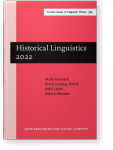The life cycle of phonological patterns explains drift in sound change
This paper addresses a classic problem in historical linguistics — ‘drift’, i.e., identical or similar
changes occurring in related languages after separation from their common ancestor — from the perspective of theoretical
historical phonology. I endorse Joseph’s (2006) view of the basic mechanism of
drift: it arises when synchronic variation, inherited from the proto- language, narrows in range to produce similar outcomes.
This paper elaborates on this proposal by identifying the mechanism that ensures inherited variation is narrowed down in
similar ways, framing it within the theory of the life cycle of phonological processes.
As proposed by Sapir (1921), ‘drift’ is often criticized for
invoking the spectre of unexplained teleological factors (‘submerged form-feeling’) driving change. It is reasonable to ask
whether parallel developments involved in ‘drift’ are ever distinct from ‘ordinary’ change. After all, change is subject not
only to random contingencies but also to universal forces, which can conspire to produce parallel developments. This is
especially pertinent for phonological change, widely agreed to be grounded in substantive biases related to the human
articulatory and auditory systems (Blevins 2004).
If we wish to disentangle the mechanism that might account specifically for drift from such universal
tendencies, it is particularly valuable to consider cases of drift with no ready universal explanation — those that involve
typologically unusual phenomena. Here, I discuss the consonant gradation systems of the Uralic languages, with a particular
focus on the Finnic and Sámi branches. I offer a reconstruction of its rise and development within the life-cycle framework.
In doing so, I highlight both the explanatory power of the theory in accounting for Sapirean drift and its heuristic value in
opening up new approaches to long-standing empirical controversies.
Article outline
- 1.The problem of drift and the life cycle
- 1.1Identifying drift
- 1.2Drift and the life cycle of phonological processes
- 2.Consonant gradation in Finnic and Sámi
- 2.1Rhythmic and syllabic gradation
- 2.2The segmental effects of consonant gradation
- 3.The life cycle of consonant gradation and drift
- 3.1Phonologization of consonant gradation
- 3.2Stabilization: Fortition or lenition?
- 3.3Rule scattering and repeated innovation
- 4.Conclusion
-
Notes
-
References
This content is being prepared for publication; it may be subject to changes.
